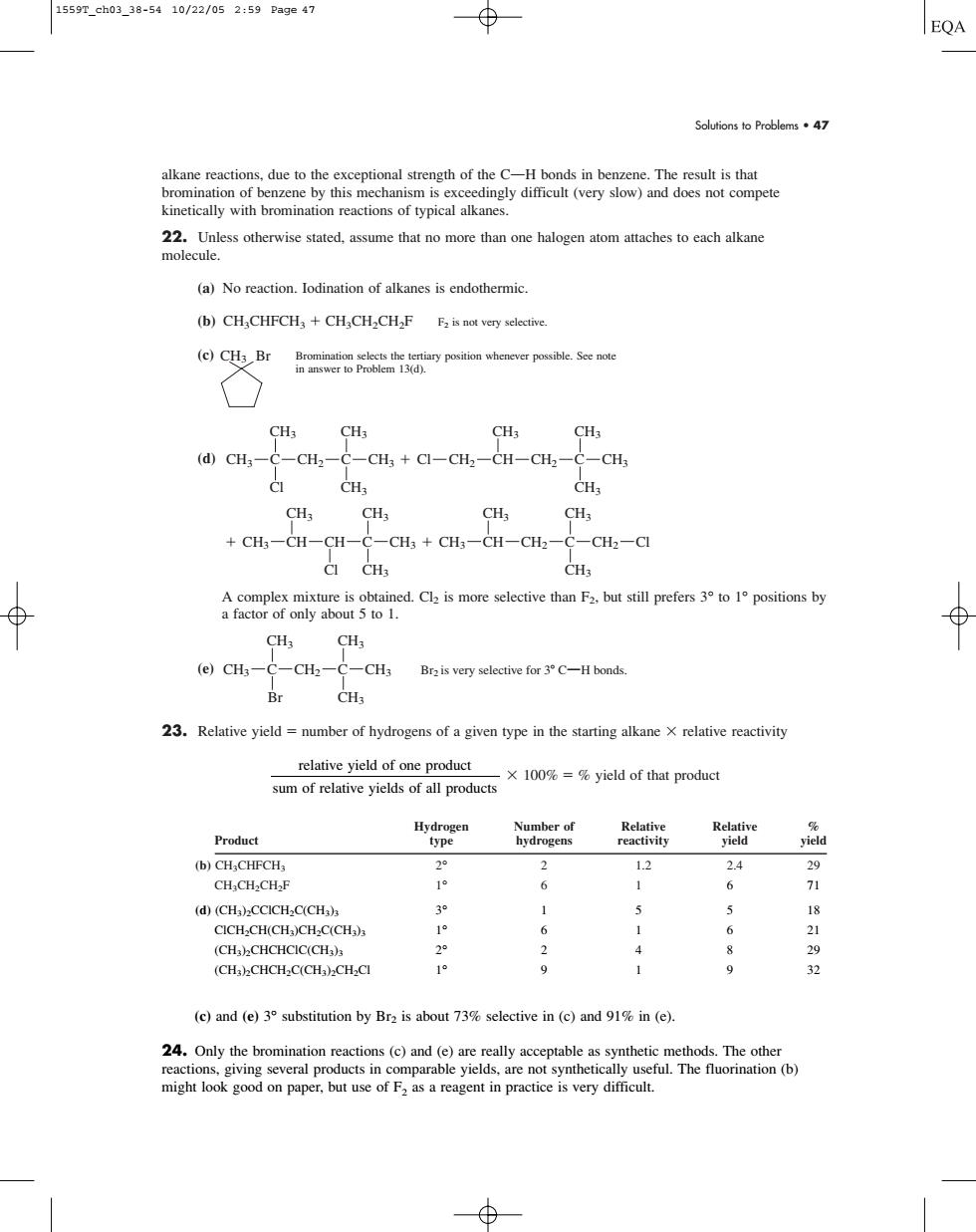正在加载图片...

1559T_ch03_38-5410/22/052:59Page47 EQA Solutions to Problems.47 alkane reaction kinetically with bromination reactions of typical alkanes (a)No reaction.lodination of alkanes is endothermic. (b)CH:CHFCH,+ OC及Br数epe CHs CH3 CH3 CH3 (d)CH3-C-CH2-C-CH3+Cl-CH2-CH-CH2-C-CH3 CH3 CH3 CH3CH3 CH,-CH-CH-C-CH;+CH;-CH-CH2-C-CH2-Cl CI CH 个g物a,cthe”的 CH3 CH, (e)CHs-C-CH2-C-CHs Br2 is very selective for 3C-H bonds 23.Relative yield=number of hydrogens of a given type in the starting alkane X relative reactivity relative vield of one product X 100%=%vield of that product sum of relative vields of all products Product Hydrogen etrtvity yield 之 (d)(CH).CCICH.C(CH) CICH-CH(CHCH.C(CH) d (CH).CHCH.C(CH.).CH.C 9 (e)and (e)3 substitution by Br2 is about 73%selective in (c)and 91%in (e). 24o mnthetic methods.The othe reactions y useful.The fluorination (b) might look good on paper,but use of F as a reagent in practice is very difficult. Solutions to Problems • 47 alkane reactions, due to the exceptional strength of the COH bonds in benzene. The result is that bromination of benzene by this mechanism is exceedingly difficult (very slow) and does not compete kinetically with bromination reactions of typical alkanes. 22. Unless otherwise stated, assume that no more than one halogen atom attaches to each alkane molecule. (a) No reaction. Iodination of alkanes is endothermic. (b) CH3CHFCH3 CH3CH2CH2F F2 is not very selective. (c) Bromination selects the tertiary position whenever possible. See note in answer to Problem 13(d). (d) A complex mixture is obtained. Cl2 is more selective than F2, but still prefers 3° to 1° positions by a factor of only about 5 to 1. (e) 23. Relative yield number of hydrogens of a given type in the starting alkane relative reactivity 100% % yield of that product Hydrogen Number of Relative Relative % Product type hydrogens reactivity yield yield (b) CH3CHFCH3 2° 2 1.2 2.4 29 CH3CH2CH2F 1° 6 1.2 6.2 71 (d) (CH3)2CClCH2C(CH3)3 3° 1 5.2 5.2 18 ClCH2CH(CH3)CH2C(CH3)3 1° 6 1.2 6.2 21 (CH3)2CHCHClC(CH3)3 2° 2 4.2 8.2 29 (CH3)2CHCH2C(CH3)2CH2Cl 1° 9 1.2 9.2 32 (c) and (e) 3° substitution by Br2 is about 73% selective in (c) and 91% in (e). 24. Only the bromination reactions (c) and (e) are really acceptable as synthetic methods. The other reactions, giving several products in comparable yields, are not synthetically useful. The fluorination (b) might look good on paper, but use of F2 as a reagent in practice is very difficult. relative yield of one product sum of relative yields of all products CH3 C CH2 CH3 CH3 Br CH3 Br2 C CH3 is very selective for 3 C—H bonds. CH3 C CH2 CH3 CH3 Cl CH3 Cl C CH3 Cl CH CH2 CH2 CH3 CH3 CH3 C CH3 CH3 CH CH2 CH3 CH3 CH3 C CH2 Cl CH3 CH3 CH3 CH C CH3 CH3 CH CH3 Br 1559T_ch03_38-54 10/22/05 2:59 Page 47��